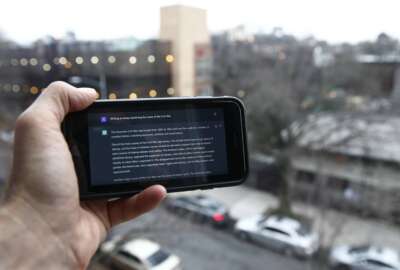What’s AI doing in the chemistry lab?
AI may not be just for automating mundane tasks. It turns out, it can do its own mixing with beakers of chemicals to create new compounds and chemistries.
AI may not be just for automating mundane tasks. It turns out, it can do its own mixing with beakers of chemicals to create new compounds and chemistries. These interactions can be used to make some interesting new technologies and materials. To learn more, Federal News Network executive producer Eric White spoke to Jen Sovada, president of Global Public Sector for SandboxAQ, one of the purveyors of these AI platforms — on the Federal Drive with Tom Temin.
Interview transcript:
Eric White
Why don’t we start there. Everyone knows what AI is capable of more and more these days, and it’s being talked about using it for data entry and things like that. But this is actually putting a lab coat on it and having do some experimentation, for doing quantum level calculations, why don’t you just kind of lay out what it is that you all have here.Jen Sovada
It’s exciting. We’ve seen recently a lot in the news, large language models. And the idea that these models can help with artificial intelligence for language. And we can do customer service, we can do software code, we can do a lot of media related things. But what we’re looking at are large quantitative models. So LQMs. And what they are, is they’re marrying artificial intelligence for physics, chemistry, biopharma as well as finance. And they really are at the forefront of taking large amounts of data, and training it based on physics based technology to produce an entirely new molecules from scratch, and getting desired sets of combinations based on the properties that we’re trying to look for.Eric White
So this is basically, I made the joke of an AI model mixing and matching on beakers, but they’re doing the lab side of things, they’re more the chalkboard in the background, so to speak.Jen Sovada
That’s exactly right, what we do is we try to figure out what types of molecules can combine together based on a set of standards or requirements from our customers, such as the US Army, and then we identify based on those parameters, what the best solutions are, and it’s probably not going to be the number one that the thing that’s going to work. But instead of giving them 250 different types of molecules, we now can give them 10 to 15 to 20 molecules based on different parameters such as toxicity, or lifecycle, or is it eco friendly? And then if we’re looking at material science, looking at things like, can it survive being shot at? Will it be a lot lighter, so that it can go on an airplane instead of on a ship? And many other types of requirements and characteristics?Eric White
It is those agreements that you have signed with the US Army that got me interested in this project? What exactly is it that they were looking for, and that you’re going to be doing with them?Jen Sovada
As we know that the Indo Pacific Theater is really an area of concentration right now, and something that all of the combatant commands, but in particular, those combatant commands like INDOPACOM, transportation commands, and many others that are focused on how do we fight and win and deter in the INDOPACOM theater for the likes of China, and also, we are moving on up into Russia, especially with the conflict we have in the Ukraine. And some of the things that the US Army has identified is that they have a lot of really good equipment, but it is based on fighting in Europe, or it is based on fighting in the Middle East. And so you think of a tank, a tank is extremely heavy. And right now, based on the size of a tank, you can actually fit two tanks in the C17, so a large cargo aircraft. But in reality, you can only put one in the aircraft because the tank is too heavy. And it maxes out the weights that a C17 can carry. And so one of the things that the US Army is interested in is, how do they build the next generation tank that enables them to have a lighter weight vehicle with the same amount of survivability, with the same ability to maneuver and sustain, but also look at something that is made of materials that are more ecologically friendly. And so what we’re doing is we’re partnering with the US Army to try to figure out what kind of molecules that they could test in the laboratory. So we’re doing it in silico. So in the computer, so that they can go and do it in the laboratory, and start with a vast smaller number of molecules to test rather than trying to pick any and every combination that’s out there in the world. The second contract we’re doing is looking at batteries. The US Army uses a lot of batteries. You think of a soldier, for example, a soldier has 10s of 20s of pounds of weight for batteries that they carry with them, because they need them to run all of the equipment that they have. As an example the US Army is looking to try to find ways how do you like batteries increase the shelf life, increase the Usage Timelines, and also not be reliant on rare earth minerals. So we’re talking to the US Army about how do we do that as well.Eric White
We’re speaking with Jen, Sovada she is the president of Global Public Sector for SandboxAQ. And so yeah, this seems like kind of a strange use for this technology. I only say strange, just because it’s not the first thing that anybody thinks of, it’s like looking at a horse and thinking that you can make glue out of it. How did this idea come about and give me a little bit of the background in history on it? Because, obviously this isn’t the first idea that people have with it.Jen Sovada
It really started with looking at how could we impact the pharmaceutical industry. COVID had a big impact on the SandboxAQ team. The sandbox started inside of Google before COVID hit. And we’ve worked through COVID, to try to identify product market fit, what were people interested in. And the idea that we had commercial companies working really, really hard to find a vaccination for COVID led us to think about how can we use quantum technology and artificial intelligence to enable us to get to drug discovery faster. Right now, the average time to go from an initial idea to a drug that’s been FDA approved and out in the market takes 16 years. With an AI simulated capability, we can decrease that by seven to 10 years of timeline, because we no longer have to do many, as many phase one, which is the early phase experiments with the different types of molecules. We can now run rapid accelerated processing of different parameters and different combinations in a computer setting in Silico, with artificial intelligence and continually training and improving our results on that data, and then give that to the pharmaceutical company that can take that data and now when they are going through their trials, they don’t have as much time that they need to complete the full lifecycle of that drug discovery. And that’s what led us to thinking about this as a bio biological process, what other biological processes are out there? And then you think about how materials are built and how batteries are built, and it’s very much in line and the same throughput of how we do it.Eric White
Applying it to the defense sector, you’d won’t have to build Los Alamos anymore to build the weapon of the future, it seems, which doesn’t make for as interesting of a movie. But what can you tell me about the potential for this and where this is headed? And what’s the status of the two ongoing projects that you do have right now.Jen Sovada
We just kicked off the project. So we’re still trying to figure out, what are we going to actually do? How long is it going to take? What are they really interested in and building that plan that we have? Because it’s this is a partnership with the army, and we hope that it will be a long term partnership with them. What’s the reality of what can happen? I think that if you think beyond what is developed today, to what can be developed tomorrow, is there’s a lot of potential there. If we can no longer need to rely on China, for rare earth minerals, for example, we’ve identified something else that we can do to create batteries that have long life, and are ecologically friendly, so that when we try to recycle them, they actually don’t create toxicity in the environment. That would be amazing. And then from a material science perspective, what’s the ability for us to create the skin of the next sixth through 10th generation fighter that we might need for the US Air Force or the US Navy? What can we do from a ship perspective to increase survivability, or from a submarine perspective where we don’t need to have submarines that weigh as much that they might be more maneuverable, that might be more survivable? Because we found even stronger materials that are lighter weight, and then we can put more into the submarine for sensing and for data collection. So I think that really your own limitations and how you think about this or what can hold you back, when in reality the options and the opportunities are endless.
Copyright © 2024 Federal News Network. All rights reserved. This website is not intended for users located within the European Economic Area.
Eric White is news anchor and Federal Drive producer at Federal News Network.
Follow @FEDERALNEWSCAST






